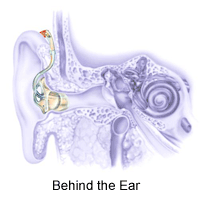Hearing Aid Features
Channels
Our speech mainly falls in the range of 250Hz to 8KHz. Different channels help to modulate speech sounds at different frequency regions. A hearing aid with many channels offers more control over amplifying speech sounds at individual frequencies.
Programmes
These are like having bifocal glasses. In every day hearing you may encounter different listening situations such as watching TV, listening to a friend in a busy market place and talking on the telephone. Each situation may require the hearing aid to process the sound in a different way. Various hearing aid programmes enable you to change the response of the hearing aid depending on the listening situation you are in, either manually or automatically.
Directional Microphones (automatic or manual)
This feature enables the hearing aid's microphone to amplify the voices of those you are speaking with, while actively reducing the levels of background noise. It is mainly useful in crowded situations and public gatherings. Automatic directional microphones constantly analyse the environment to automatically select the best sound processing strategy to use in noisy places.
Feedback Management
This feature actively switches on when feedback is detected (ie. whistling of the aid) and reduces or eliminates the feedback by actively reducing the gain in the specific frequency.
Telecoil
 These are useful in listening through an induction loop system or a tele-loop system. Tele loop or induction loop systems are installed in many theatres, churches, public places and in some telephones. You will be able to see the sign (shown to the right) in public places that have this system installed.
These are useful in listening through an induction loop system or a tele-loop system. Tele loop or induction loop systems are installed in many theatres, churches, public places and in some telephones. You will be able to see the sign (shown to the right) in public places that have this system installed.
Data Logging
More recent digital hearing aids have this feature to store information on how the hearing aid has been used. This helps the hearing aid Audiologists to fine tune the hearing aid to best suit your needs. For example, if the hearing aid recorded that the volume had to be constantly turned up, the Audiologist may be able to improve the overall amplification of the aid during the next follow up visit.
Data Learning
Hearing aids are not glasses. The central auditory system takes time to get acclimatised to listening to sounds through the hearing aids. As all new users need some time to get used to their hearing aids, patients find it useful to be eased into amplification. Therefore, experience levels can be set so that the user gradually achieves the full amplification and sound processing over a period of time.
Hearing aid technology has become very sophisticated over the last few years. It is now insufficient to say that a hearing aid is simply 'digital'. There are many features, such as those explained above, that have advanced digital hearing aid technology. At Vida Percy Audiologists we will discuss your individual requirements to decide which hearing aid features are most suitable for you.
Hearing aid images courtesy of Siemens, Oticon, Coselgi and Widex
Take Stock of your Hearing with our online questionnaire

- Turning TV louder than normal
- Missing Telephone or door bell ring
- Difficulty having a conversation over the phone
- Difficulty hearing people when they are not facing you
- Difficulty hearing in small/big groups with background noises
- Asking for frequent repetitions in a conversation

